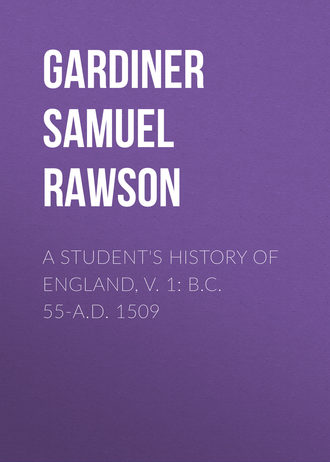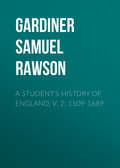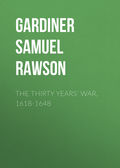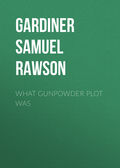
Gardiner Samuel Rawson
A Student's History of England, v. 1: B.C. 55-A.D. 1509
13. Eadmund (940-946) and Eadred (946-955).—Æthelstan died in 940. He was succeeded by his young brother, Eadmund, who had fought bravely at Brunanburh. Eadmund had to meet a general rising of the Danes of Mercia as well as of those of the north. After he had suppressed the rising he showed himself to be a great statesman as well as a great warrior. The relations between the king of the English and the king of the Scots had for some time been very uncertain. Little is definitely known about them but it looks as if they joined the English whenever they were afraid of the Danes, and joined the Danes whenever they were afraid of the English. Eadmund took an opportunity of making it to be the interest of the Scottish king permanently to join the English. The southern part of the kingdom of Strathclyde had for some time been under the English kings. In 945 Eadmund overran the remainder, but gave it to Malcolm on condition that he should be his fellow-worker by sea and land. The king of Scots thus entered into a position of dependent alliance towards Eadmund. A great step was thus taken in the direction in which the inhabitants of Britain afterwards walked. The dominant powers in the island were to be English and Scots, not English and Danes. Eadmund thought it worth while to conciliate the Scottish Celts rather than to endeavour to conquer them. The result of Eadmund's statesmanship was soon made manifest. He himself did not live to gather its fruits. In 946 an outlaw who had taken his seat at a feast in his hall slew him as he was attempting to drag him out by the hair. The next king, Eadred, the last of Eadward's sons, though sickly, had all the spirit of his race. He had another sharp struggle with the Danes, but in 954 he made himself their master. North-humberland was now thoroughly amalgamated with the English kingdom, and was to be governed by an Englishman, Oswulf, with the title of Earl, an old Danish title equivalent to the English Ealdorman, having nothing to do, except philologically, with the old English word Eorl.
14. Danes and English.—In 955 Eadred died, having completed the work which Ælfred had begun, and which had been carried on by his son and his three grandsons. England, from the Forth to the Channel, was under one ruler. Even the contrast between Englishmen and Danes was soon, for the most part, wiped out. They were both of the same Teutonic stock, and therefore their languages were akin to one another and their institutions very similar. The Danes of the north were for some time fiercer and less easily controlled than the English of the south, but there was little national distinction between them, and what little there was gradually passed away.
15. Eadwig. 955—959.—Eadred was succeeded by Eadwig, the eldest son of his brother Eadmund. Eadwig was hardly more than fifteen years old, and it would be difficult for a boy to keep order amongst the great ealdormen and earls. At his coronation feast he gave deep offence by leaving his place to amuse himself with a young kinswoman, Ælfgifu, in her mother's room, whence he was followed and dragged back by two ecclesiastics, one of whom was Dunstan, Abbot of Glastonbury.
16. Dunstan.—Dunstan in his boyhood had been attached to Eadmund's court, but he had been driven off by the rivalry of other youths. He was in no way fitted to be a warrior. He loved art and song, and preferred a book to a sword. For such youths there was no place amongst the fighting laymen, and Dunstan early found the peace which he sought as a monk at Glastonbury. Eadmund made him abbot, but Dunstan had almost to create his monastery before he could rule it. Monasteries had nearly vanished from England in the time of the Danish plunderings, and the few monks who remained had very little that was monastic about them. Dunstan brought the old monks into order, and attracted new ones, but to the end of his days he was conspicuous rather as a scholar than as an ascetic. From Glastonbury he carried on the work of teaching an ignorant generation, just as Ælfred had done in an earlier time. Ælfred, however, was a warrior and a ruler first, and then a teacher. Dunstan was a teacher first, and then a ruler. Eadred took counsel with him, and Dunstan became thus the first example of a class of men which afterwards rose to power—that, namely, of ecclesiastical statesmen. Up to that time all who had governed had been warriors.
17. Archbishop Oda.—Another side of the Church's work, the maintenance of a high standard of morality, was, in the time of Eadred, represented by Oda, Archbishop of Canterbury. The accepted standard of morality differs in different ages, and, for many reasons, it was held by the purer minds in the tenth century that celibacy was nobler than marriage. If our opinion is changed now, it is because many things have changed. No one then thought of teaching a girl anything, except to sew and to look after the house, and an ignorant and untrained wife could only be a burden to a man who was intent upon the growth of the spiritual or intellectual life in himself and in others. At all times the monks, who were often called the regular clergy, because they lived according to a certain rule, had been unmarried, and attempts had frequently been made by councils of the Church to compel the parish priests, or secular clergy, to follow their example. In England, however, and on the Continent as well, these orders were seldom heeded, and a married clergy was everywhere to be found. Of late, however, there had sprung up in the monastery of Cluny, in Burgundy, a zeal for the establishment of universal clerical celibacy, and this zeal was shared by Archbishop Oda, though he found it impossible to overcome the stubborn resistance of the secular clergy.

A monk driven out of the King's presence.
(From a drawing belonging to the Society of Antiquaries.)
18. Eadwig's Marriage.—In its eagerness to set up a pure standard of morality, the Church had made rules against the marriage of even distant relations. Eadwig offended against these rules by marrying his kinswoman, Ælfgifu. A quarrel arose on this account between Dunstan and the young king, and Dunstan was driven into banishment. Such a quarrel was sure to weaken the king, because the support of the bishops was usually given to him, for the sake of the maintenance of peace and order. The dispute came at a bad time, because there was also a quarrel among the ealdormen and other great men. At last the ealdormen of the north and centre of England revolted and set up the king's brother, Eadgar, to be king of all England north of the Thames. Upon this, Oda, taking courage, declared Eadwig and his young wife to be separated as too near of kin, and even seized her and had her carried beyond sea. In 959 Eadwig died, and Eadgar succeeded to the whole kingdom.
CHAPTER V.
EADGAR'S ENGLAND
1. Eadgar and Dunstan. 959—975.—Eadgar was known as the Peaceful King. He had the advantage, which Eadwig had not, of having the Church on his side. He maintained order, with the help of Dunstan as his principal adviser. Not long after his accession Dunstan became Archbishop of Canterbury. His policy was that of a man who knows that he cannot do everything and is content to do what he can. The Danes were to keep their own laws, and not to have English laws forced upon them. The great ealdormen were to be conciliated, not to be repressed. Everything was to be done to raise the standard of morality and knowledge. Foreign teachers were brought in to set up schools. More than this Dunstan did not attempt. It is true that in his time an effort was made to found monasteries, which should be filled with monks living after the stricter rule of which the example had been set at Cluny, but the man who did most to establish monasteries again in England was not Dunstan, but Æthelwold, Bishop of Winchester. Æthelwold, however, was not content with founding monasteries. He also drove out the secular canons from his own cathedral of Winchester and filled their places with monks. His example was followed by Oswald, Bishop of Worcester. Dunstan did not introduce monks even into his own cathedrals at Worcester and Canterbury. As far as it is now possible to understand the matter, the change, though it provoked great hostility, was for the better. The secular canons were often married, connected with the laity of the neighbourhood, and living an easy life. The monks were celibate, living according to a strict rule, and conforming themselves to what, according to the standard of the age, was the highest ideal of religion. By a life of complete self-denial they were able to act as examples to a generation which needed teaching by example more than by word. How completely monasticism was associated with learning is shown by the fact that the monks now established at Worcester took up the work of continuing the Chronicle which had been begun under Ælfred (see p. 61).
2. The Cession of Lothian.—It is said that Eadgar was once rowed by six kings on the river Dee. The story, though probably untrue, sets forth his power not only over his own immediate subjects but over the whole island. His title of Peaceful shows that at least he lived on good terms with his neighbours. There is reason to believe that he was able to do this because he followed out the policy of Eadmund in singling out the king of Scots as the ruler whom it was most worth his while to conciliate. Eadmund had given over Strathclyde to one king of Scots. Eadgar, it is said—and probably with truth—gave over Lothian to another. Lothian was then the name of the whole of the northern part of Bernicia stretching from the Cheviots to the Forth. In Eadred's time the Scots had occupied Eadwinesburh (Edinburgh), the northern border fortress of Bernicia (see p. 43), and after this the land to the south of that fortress must have been difficult to defend against them. It is therefore likely that the story is true that Eadgar ceded Lothian to Kenneth, who was then king of the Scots, especially as it would account for the peaceful character of his reign. Kenneth in accepting the gift no doubt engaged to be faithful to Eadgar, though it is impossible to say what was the exact nature of his obligation. It is of more importance that a Celtic king ruled thenceforward over an English people as well as over his own Celtic Scots, and that ultimately his descendants became more English than Celtic in character, through the attraction exercised upon them by their English subjects.
3. Changes in English Institutions.—The long struggle with the Danes could not fail to leave its mark upon English society. The history of the changes which took place is difficult to trace; in the first place because our information is scanty, in the second because things happened in one part of the country which did not happen in another. Yet there were two changes which were widely felt: the growth of the king's authority, and the acceleration of the process which was reducing to bondage the ceorl, or simple freeman.
4. Growth of the King's Power.—In the early days of the English conquest the kings and other great men had around them their war-bands, composed of gesiths or thegns, personally attached to themselves, and ready, if need were, to die on their lord's behalf. Very early these thegns were rewarded by grants of land on condition of continuing military service. Every extension of the king's power over fresh territory made their services more important. It had always been difficult to bring together the fyrd, or general army of the freemen, even of a small district, and it was quite impossible to bring together the fyrd of a kingdom reaching from the Channel to the Firth of Forth. Ælfred's division of the fyrd into two parts, one to fight and the other to stay at home, may have served when all the fighting had to be done in the western part of Wessex. Æthelstan or Eadmund could not possibly make even half of the men of Devonshire or Essex fight in his battles north of the Humber. The kings therefore had to rely more and more upon their thegns, who in turn had thegns of their own whom they could bring with them; and thus was formed an army ready for military service in any part of the kingdom. A king who could command such an army was even more powerful than one who could command the whole of the forces of a smaller territory.

Rural life in the eleventh century. January to June.
(Cott. MS. Julius A. vi.)

Rural life in the eleventh century. July to December.
(Cott. MS. Julius A. vi.)]
5. Conversion of the Freemen into Serfs.—It is impossible to give a certain account of the changes which passed over the English freemen, but there can be little doubt that a process had been for some time going on which converted them into bondmen, and that this process was greatly accelerated by the Danish wars. When a district was being plundered the peasant holders of the strips of village land suffered most, and needed the protection of the neighbouring thegn, who was better skilled in war than themselves, and this protection they could only obtain on condition of becoming bondmen themselves—that is to say, of giving certain days in the week to work on the special estate of the lord. A bondman differed both from a slave and from a modern farmer. Though he was bound to the soil and could not go away if he wished to do so, yet he could not be sold as though he were a slave; nor, on the other hand, could he, like a farmer, be turned out of his holding so long as he fulfilled his obligation of cultivating his lord's demesne. The lord was almost invariably a thegn, either of the king or of some superior thegn, and there thus arose in England, as there arose about the same time on the Continent, a chain of personal relationships. The king was no longer merely the head of the whole people. He was the personal lord of his own thegns, and they again were the lords of other thegns. The serfs cultivated their lands, and thereby set them free to fight for the king on behalf of the whole nation. It seems at first sight as if the English people had fallen into a worse condition. An organisation, partly military and partly servile, was substituted for an organisation of free men. Yet only in this way could the whole of England be amalgamated. The nation gained in unity what it lost in freedom.
6. The Hundred-moot and the Lord's Court.—In another way the condition of the peasants was altered for the worse by the growth of the king's power. In former days land was held as 'folkland,' granted by the people at the original conquest, passing to the kinsmen of the holder if he died without children. Afterwards the clergy introduced a system by which the owner could grant the 'bookland,' held by book or charter, setting at nought the claim of his kinsmen, and in order to give validity to the arrangement, obtained the consent of the king and his Witenagemot (see p. 45). In time, the king and the Witenagemot granted charters in other cases, and the new 'bookland' to a great extent superseded the old 'folkland,' accompanied by a grant of the right of holding special courts. In this manner the old hundred-moots became neglected, people seeking for justice in the courts of the lords. Yet those who lived on the lord's land attended his court, appeared as compurgators, and directed the ordeal just as they had once done in the hundred-moot.
7. The Towns.—The towns had grown up in various ways. Some were of old Roman foundation, such as Lincoln and Gloucester. Others, like Nottingham and Bristol, had come into existence since the English settlement. Others again gathered round monasteries, like Bury St. Edmunds and Peterborough. The inhabitants met to consult about their own affairs, sometimes in dependence on a lord. Where there was no lord they held a court which was composed in the same way as the hundred-moots outside. The townsmen had the right of holding a market. Every sale had to take place in the presence of witnesses who could prove, if called upon to do so, that the sale had really taken place, and markets were therefore usually to be found in towns, because it was there that witnesses could most easily be found.
8. The Origin of the Shires.—Shires, which were divisions larger than the hundreds, and smaller than the larger kingdoms, originated in various ways. In the south, and on the east coast as far north as the Wash, they were either old kingdoms like Kent and Essex, or settlements forming part of old kingdoms, as Norfolk (the north folk) formed part of East Anglia, and Dorset or Somerset, the lands of the Dorsætan or the Somersætan, formed part of the kingdom of Wessex. In the centre and north they were of more recent origin, and were probably formed as those parts of England were gradually reconquered from the Danes. The fact that most of these shires are named from towns—as Derbyshire from Derby, and Warwickshire from Warwick—shows that they came into existence after towns had become of importance.
9. The Shire-moot.—Whilst the hundred-moot decayed, the folk-moot continued to flourish under a new name, as the shire-moot. This moot was still attended by the freemen of the shire though the thegns were more numerous and the simple freemen less numerous than they had once been. Still the continued existence of the shire-moot kept up the custom of self-government more than anything else in England. The ordeals were witnessed, the weregild inflicted, and rights to land adjudged, not by an officer of the king, but by the landowners of the shire assembled for the purpose. These meetings were ordinarily presided over by the ealdorman, who appeared as the military commander and the official head of the shire, and by the bishop, who represented the Church. Another most important personage was the sheriff, or shire-reeve, whose business it was to see that the king had all his rights, to preside over the shire-moot when it sat as a judicial court, and to take care that its sentences were put in execution.

Walker & Boutallse.
Plan and section of a burh of the eleventh century at Laughton-en-Le-Morthen, Yorks.
10. The Ealdormen and the Witenagemot.—During the long fight with the Danes commanders were needed who could lead the forces of more than a single shire. Before the end of Eadred's reign there were ealdormen who ruled over many shires. One of them for instance, Æthelstan, Ealdorman of East Anglia, and of the shires immediately to the west of East Anglia, was so powerful that he was popularly known as the Half-King. Such ealdormen had great influence in their own districts, and they also were very powerful about the king. The king could not perform any important act without the consent of the Witenagemot, which was made up of three classes—the Ealdormen, the Bishops, and the greater Thegns. When a king died the Witenagemot chose his successor out of the kingly family; its members appeared as witnesses whenever the king 'booked' land to any one; and it even, on rare occasions, deposed a king who was unfit for his post. In the days of a great warrior king like Eadward or Eadmund, members of the Witenagemot were but instruments in his hands, but if a weak king came upon the throne, each member usually took his own way and pursued his own interest rather than that of the king and kingdom.
11. The Land.—The cultivated land was surrounded either by wood or by pasture and open commons. Every cottager kept his hive of bees, to produce the honey which was then used as we now use sugar, and drove his swine into the woods to fatten on the acorns and beech nuts which strewed the ground in the autumn. Sheep and cattle were fed on the pastures, and horses were so abundant that when the Danish pirates landed they found it easy to set every man on horseback. Yet neither the Danes nor the English ever learnt to fight on horseback. They rode to battle, but as soon as they approached the enemy they dismounted to fight on foot.

Glass tumbler. (British Museum.)
12. Domestic Life.—The huts of the villagers clustered round the house of the lord. His abode was built in a yard surrounded for protection by a mound and fence, whilst very great men often established themselves in burhs, surrounded by earthworks, either of their own raising or the work of earlier times. Its principal feature was the hall, in which the whole family with the guests and the thegns of the lord met for their meals. The walls were covered with curtains worked in patterns of bright colours. The fire was lighted on the hearth, a broad stone in the middle, over which was a hole in the roof through which the smoke of the hall escaped. The windows were narrow, and were either unclosed holes in the wall, or covered with oiled linen which would admit a certain amount of light.

Drinking glass. (British Museum.)
13. Food and Drink.—In a great house at meal-time boards were brought forward and placed on tressels. Bread was to be had in plenty, and salt butter. Meat too, in winter, was always salted, as turnips and other roots upon which cattle are now fed in winter were wholly unknown, and it was therefore necessary to kill large numbers of sheep and oxen when the cold weather set in. There were dishes, but neither plates nor forks. Each man took the meat in his fingers and either bit off a piece or cut it off with a knife. The master of the house sat at the head of the table, and the lady handed round the drink, and afterwards sat down by her husband's side. She, however, with any other ladies who might be present, soon departed to the chamber which was their own apartment. The men continued drinking long. The cups or glasses which they used were often made with the bottoms rounded so as to force the guests to keep them in their hands till they were empty. The usual drink was mead, that is to say, fermented honey, or ale brewed from malt alone, as hops were not introduced till many centuries later. In wealthy houses imported wine was to be had. English wine was not unknown, but it was so sour that it had to be sweetened with honey. It was held to be disgraceful to leave the company as long as the drinking lasted, and drunkenness and quarrels were not unfrequent. Wandering minstrels who could play and sing or tell stories were always welcome, especially if they were jugglers as well, and could amuse the company by throwing knives in the air and catching them as they fell, or could dance on their hands with their legs in the air. When the feast was over, the guests and dependents slept on the floor on rugs or straw, each man taking care to hang his weapons close to his head on the wall, to defend himself in case of an attack by robbers in the night. The lord retired to his chamber, whilst the unmarried ladies occupied bowers, or small rooms, each with a separate door opening on to the yard. Their only beds were bags of straw. Neither men nor women wore night-dresses of any kind, but if they took off their clothes at all, wrapped themselves in rugs.

Comb and case of Scandinavian type, found at York.
(Now in the British Museum.)






